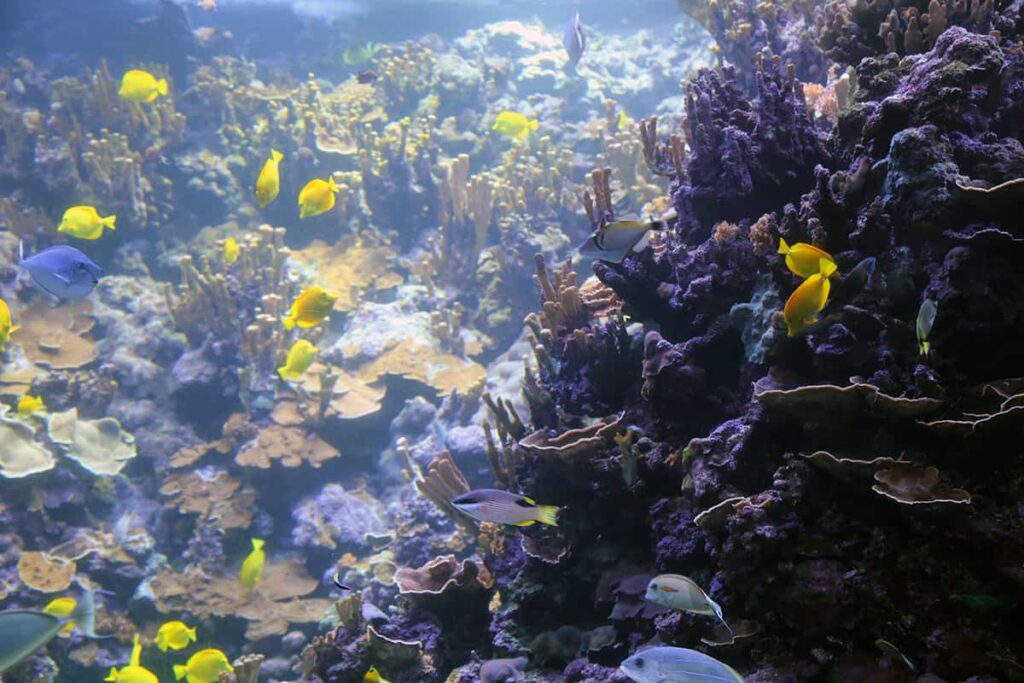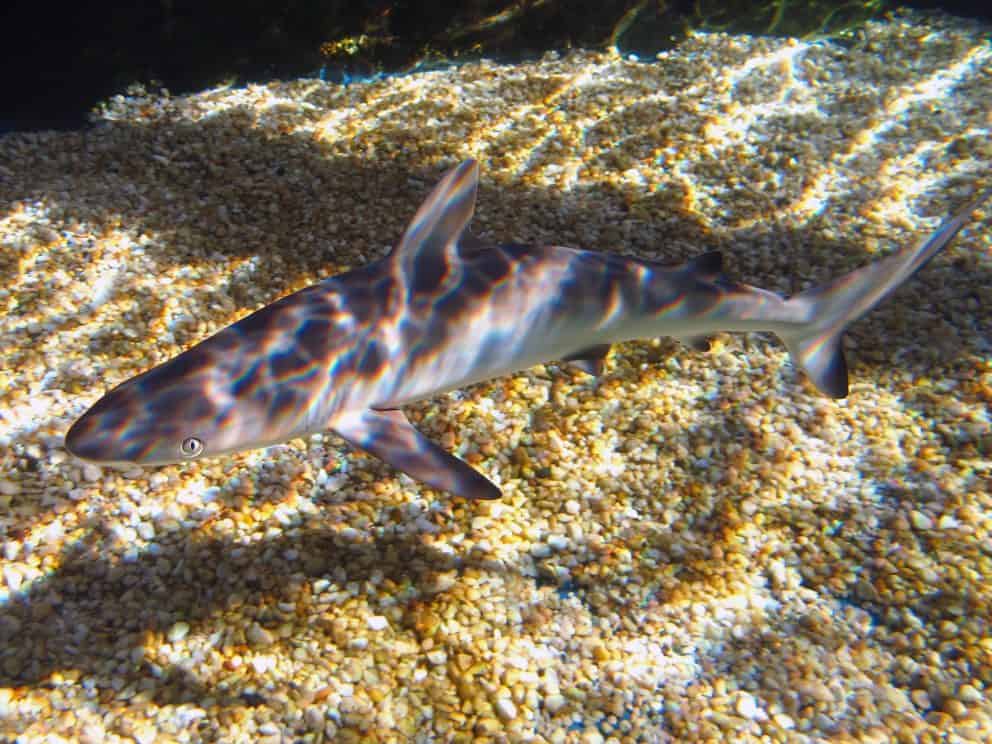Home to one of the world’s largest displays of live Pacific corals, Maui Ocean Center offers a startling, up-close view of these rare and beautiful creatures. Our Living Reef showcases over 40 Hawaiian coral species that range from shallow to deep-reef environments.
Maui Ocean Center has successfully raised and maintained coral colonies since 1998. Our exhibits receive saltwater directly from Mā‘alaea Bay, resulting in environments that allow fish, corals, and other marine invertebrates to thrive.
The Kumulipo, the Hawaiian creation chant, begins with the emergence of a coral polyp. After witnessing the splendor of the living reef, it’s easy to see how corals represent the very genesis of life in the sea.
The exhibit features a large tank filled with approximately 18,000 gallons of saltwater, carefully designed to mimic the natural conditions of a coral reef. Coral reefs are often referred to as the “rainforests of the sea” due to their incredible biodiversity and importance to marine ecosystems. The Living Reef exhibit showcases the different types of coral formations, including branching corals, brain corals, and fan corals, each with its unique shape, color, and texture. These corals provide a habitat for numerous fish species, which dart in and out of the nooks and crevices, creating a mesmerizing display of movement and color.
One of the highlights of the Living Reef exhibit is the opportunity to witness the symbiotic relationship between corals and various marine organisms. Visitors can observe tiny cleaner shrimp meticulously grooming fish. The exhibit also showcases other fascinating reef inhabitants such as sea stars (Pe ̀a / pe ̀ape ̀a / hōkū-kau), sea cucumbers (Loli), and sea urchins (wana / ‘ina / hāwae / haukèke), which contribute to the overall biodiversity and ecological balance of the reef.

The Shallow Reef Exhibit offers a glimpse into the intricate and diverse components of a Hawaiian coral reef ecosystem. Despite their rocky appearance, corals are fascinating animals belonging to the cnidarian group, just like sea jellies and anemones. Each coral polyp, though small, contributes to the colony’s overall structure by secreting calcium carbonate, which builds up over time to form the entire reef.
Beyond their structural role, corals provide vital food and shelter for other reef inhabitants. They capture and consume plankton using their tentacles and stinging cells, but they also rely on a symbiotic relationship with tiny algae called zooxanthellae. These algae live within the coral tissue, providing nutrients through photosynthesis and giving corals their vibrant colors.
The Mid Reef Exhibit at the Maui Ocean Center offers a unique experience as it exclusively showcases marine animals found in Hawaiian waters. With a dedicated curatorial team that collects and releases organisms under a special state permit, the exhibit boasts a dynamic and ever-changing population.
Within the Mid Reef exhibit, visitors can marvel at over 20 different species of reef fish, providing a realistic representation of the thriving reef community in Hawaiʻi. Each fish’s design is perfectly adapted to its specific ecological role. Fish with similar physical characteristics often belong to the same family, indicating their relatedness.
Hawaiian waters are home to several easily identifiable fish families. For example, the surgeonfish family displays a distinctive sharp spine resembling a surgeon’s scalpel at the base of their tails. The unicorn fish family features a conical structure on their heads or two sets of spines at the base of their tails. Butterflyfish (Lauwiliwili nukunuku ‘oi‘oi), known for their pointed mouths and vibrant bodies, are specialized in feeding on tiny coral polyps and worms. Triggerfish possess powerful jaws and unique trigger-like fins that serve as a self-defense mechanism. The wrasse family (hīnālea) showcases various shapes, sizes, and colors, utilizing their strong pectoral fins for propulsion.
Among the fascinating species in the exhibit, keep an eye out for the Hawaiian cleaner wrasse. This particular wrasse engages in symbiotic cleaning behavior, picking off parasites and dead skin cells from other fish. Such intricate interactions highlight the importance of reef fish in maintaining the overall health of coral reef ecosystems.

The Deep Reef exhibit at the Maui Ocean Center offers visitors a glimpse into the unique and mysterious environment that lies approximately 100 feet below the ocean’s surface. Unlike the shallower reef environments, the deep reef is characterized by a lack of sunlight, making it challenging for photosynthetic organisms like coral to thrive. Instead, the corals found in this exhibit rely on chemosynthesis, deriving their nutrition from inorganic compounds. These deep reef corals have a distinct appearance, being long, thin, and branch-like compared to their shallow-water counterparts. Despite the challenging conditions, the deep reef is home to various fascinating creatures, including juvenile blacktip reef sharks (Manō Pā‘ele), also known as shark pups. These fragile young sharks seek shelter in the deep reef to avoid larger predators.
At the Maui Ocean Center, the curatorial team collects shark pups under a special state permit to provide them a safe environment for growth and to educate visitors about these magnificent creatures. By dispelling misconceptions and fostering understanding, the center aims to contribute to the conservation of sharks and promote their vital role in the marine ecosystem.
Visitors also may encounter a variety of fish species that are adapted to the deep reef environment. These fish have different shapes, sizes, and colors that allow them to thrive in the deep waters. The exhibit may also feature other organisms found in the deep reef, such as crustaceans, mollusks, and other invertebrates that have adapted to survive in the dimly lit and high-pressure conditions.
The Deep Reef Exhibit provides visitors with a rare opportunity to explore and learn about the mysterious and lesser-known aspects of the ocean. It highlights the importance of understanding and protecting the deep reef ecosystems, which play a crucial role in the overall health and biodiversity of the marine environment.
Immerse Yourself in our SEA-News featuring Hawaiʻi’s marine life, inspirational conservation, and glimpses behind-the-scenes.